Leica V-LUX 3 vs Panasonic FZ150
The Leica V-LUX 3 and the Panasonic Lumix DMC-FZ150 are two digital cameras that were announced, respectively, in December 2011 and August 2011. Both the V-LUX 3 and the FZ150 are fixed lens compact cameras that are equipped with a 1/2.3-inch sensor. Both cameras offer a resolution of 12 megapixels.
Below is an overview of the main specs of the two cameras as a starting point for the comparison.

Check V-LUX 3 offers at
ebay.com

Check FZ150 offers at
ebay.com
Going beyond this snapshot of core features and characteristics, what are the differences between the Leica V-LUX 3 and the Panasonic Lumix DMC-FZ150? Which one should you buy? Read on to find out how these two cameras compare with respect to their body size, their imaging sensors, their shooting features, their input-output connections, and their reception by expert reviewers.
Body comparison
An illustration of the physical size and weight of the Leica V-LUX 3 and the Panasonic FZ150 is provided in the side-by-side display below. The two cameras are presented according to their relative size. Three successive views from the front, the top, and the rear are shown. All width, height and depth dimensions are rounded to the nearest millimeter.
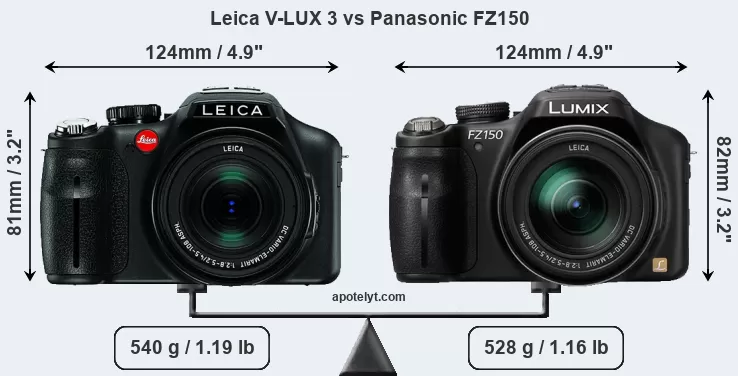
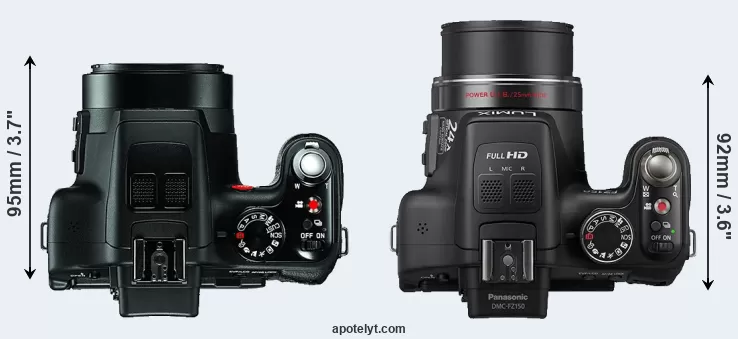
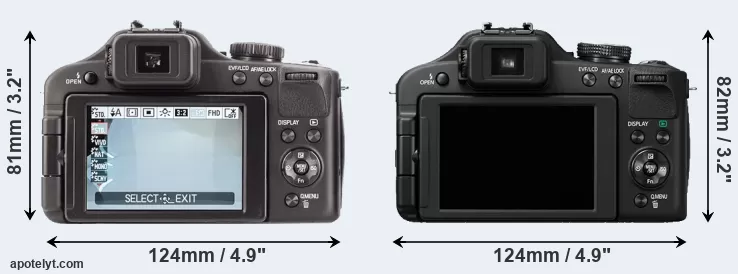
If the front view area (width x height) of the cameras is taken as an aggregate measure of their size, the Panasonic FZ150 is somewhat larger (1 percent) than the Leica V-LUX 3. However, the FZ150 is slightly lighter (2 percent) than the V-LUX 3. In this context, it is worth noting that neither the V-LUX 3 nor the FZ150 are weather-sealed.
The adjacent table lists the principal physical characteristics of the two cameras alongside a wider set of alternatives. In case you want to display and compare another camera duo, you can use the CAM-parator app to select your camera combination among a large number of options.

| Camera Model |
Camera Width |
Camera Height |
Camera Depth |
Camera Weight |
Battery Life |
Weather Sealing |
Camera Launch |
Launch Price (USD) |
Street Price |
||
|---|---|---|---|---|---|---|---|---|---|---|---|
| 1. | Leica V-LUX 3 | 124 mm | 81 mm | 95 mm | 540 g | 410 | n | Dec 2011 | 949 | ebay.com | |
| 2. | Panasonic FZ150 | 124 mm | 82 mm | 92 mm | 528 g | 410 | n | Aug 2011 | 499 | ebay.com | |
| 3. | Canon G1 X | 117 mm | 81 mm | 65 mm | 534 g | 250 | n | Jan 2012 | 799 | ebay.com | |
| 4. | Canon G1 X Mark II | 116 mm | 74 mm | 66 mm | 553 g | 240 | n | Feb 2014 | 799 | ebay.com | |
| 5. | Canon SX30 | 123 mm | 92 mm | 108 mm | 601 g | 370 | n | Sep 2010 | 429 | ebay.com | |
| 6. | Canon SX40 | 123 mm | 92 mm | 108 mm | 600 g | 380 | n | Sep 2011 | 429 | ebay.com | |
| 7. | Canon SX50 | 123 mm | 87 mm | 106 mm | 595 g | 315 | n | Sep 2012 | 429 | ebay.com | |
| 8. | Leica V-LUX 2 | 124 mm | 80 mm | 95 mm | 520 g | 410 | n | Sep 2010 | 849 | ebay.com | |
| 9. | Leica V-LUX 4 | 125 mm | 87 mm | 110 mm | 588 g | 540 | n | Sep 2012 | 949 | ebay.com | |
| 10. | Panasonic FZ100 | 124 mm | 82 mm | 92 mm | 540 g | 410 | n | Jul 2010 | 499 | ebay.com | |
| 11. | Panasonic FZ200 | 125 mm | 87 mm | 110 mm | 588 g | 540 | n | Jul 2012 | 599 | ebay.com | |
| 12. | Panasonic LX5 | 110 mm | 65 mm | 43 mm | 271 g | 400 | n | Jul 2010 | 499 | ebay.com | |
| Note: Measurements and pricing do not include easily detachable parts, such as add-on or interchangeable lenses or optional viewfinders. | |||||||||||
Any camera decision will naturally be influenced heavily by the price. The retail prices at the time of the camera’s release place the model in the market relative to other models in the producer’s line-up and the competition. The FZ150 was launched at a markedly lower price (by 47 percent) than the V-LUX 3, which puts it into a different market segment. Usually, retail prices stay at first close to the launch price, but after several months, discounts become available. Later in the product cycle and, in particular, when the replacement model is about to appear, further discounting and stock clearance sales often push the camera price considerably down.
Sensor comparison
The size of the imaging sensor is a crucial determinant of image quality. A large sensor will tend to have larger individual pixels that provide better low-light sensitivity, wider dynamic range, and richer color-depth than smaller pixel-units in a sensor of the same technological generation. Further, a large sensor camera will give the photographer additional creative options when using shallow depth-of-field to isolate a subject from its background. On the downside, larger sensors are more costly to manufacture and tend to lead to bigger and heavier cameras and lenses.
Both cameras under consideration feature a 1/2.3-inch sensor and have a format factor (sometimes also referred to as "crop factor") of 5.6. Within the spectrum of camera sensors, this places the review cameras among the smaller-sensor digicams that favor affordability and compact design. Both cameras feature a native aspect ratio (sensor width to sensor height) of 4:3.
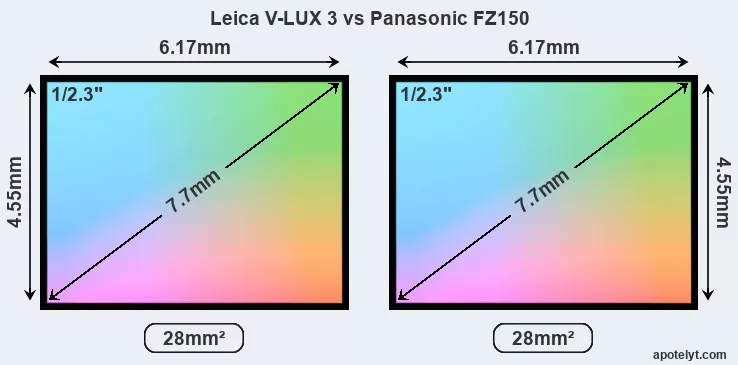
The two cameras under review do not only share the same sensor size, but also offer an identical resolution of 12 megapixels. This similarity in sensor specs implies that both the V-LUX 3 and the FZ150 have the same pixel density, as well as the same pixel size. It should, however, be noted that the V-LUX 3 is a somewhat more recent model (by 3 months) than the FZ150, and its sensor might have benefitted from technological advances during this time. Coming back to sensor resolution, it should be mentioned that neither of the two cameras has an anti-alias filter installed, so they are able to capture all the detail the sensor resolves.
The Leica V-LUX 3 has a native sensitivity range from ISO 100 to ISO 3200, which can be extended to ISO 100-6400. The Panasonic Lumix DMC-FZ150 offers exactly the same ISO settings.
Technology-wise, both cameras are equipped with CMOS (Complementary Metal–Oxide–Semiconductor) sensors. Both cameras use a Bayer filter for capturing RGB colors on a square grid of photosensors. This arrangement is found in most digital cameras.
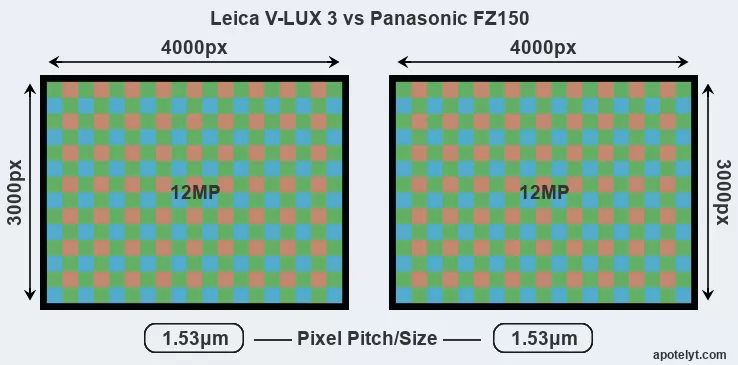
Since 2007, DXO Mark has published sensor performance measurements that have been derived using a consistent methodology. This service determines an overall sensor rating, as well as sub-scores for low-light sensitivity ("DXO Sports"), dynamic range ("DXO Landscape"), and color depth ("DXO Portrait"). The following table provides an overview of the physical sensor characteristics, as well as the sensor quality measurements for a selection of comparators.

| Camera Model |
Sensor Class |
Resolution (MP) |
Horiz. Pixels |
Vert. Pixels |
Video Format |
DXO Portrait |
DXO Landscape |
DXO Sports |
DXO Overall |
||
|---|---|---|---|---|---|---|---|---|---|---|---|
| 1. | Leica V-LUX 3 | 1/2.3 | 12.0 | 4000 | 3000 | 1080/60p | 19.7 | 11.0 | 430 | 42 | |
| 2. | Panasonic FZ150 | 1/2.3 | 12.0 | 4000 | 3000 | 1080/60p | 19.4 | 10.9 | 132 | 40 | |
| 3. | Canon G1 X | 1.5-inch | 14.2 | 4352 | 3264 | 1080/24p | 21.7 | 10.8 | 644 | 60 | |
| 4. | Canon G1 X Mark II | 1.5-inch | 13.0 | 4160 | 3120 | 1080/30p | 21.5 | 10.8 | 581 | 58 | |
| 5. | Canon SX30 | 1/2.3 | 14.0 | 4320 | 3240 | 720/30p | 19.4 | 10.7 | 320 | 39 | |
| 6. | Canon SX40 | 1/2.3 | 12.0 | 4000 | 3000 | 1080/24p | 19.6 | 10.9 | 409 | 41 | |
| 7. | Canon SX50 | 1/2.3 | 12.0 | 4000 | 3000 | 1080/24p | 20.3 | 11.2 | 179 | 47 | |
| 8. | Leica V-LUX 2 | 1/2.3 | 14.0 | 4320 | 3240 | 1080/60i | 19.4 | 10.7 | 321 | 39 | |
| 9. | Leica V-LUX 4 | 1/2.3 | 12.0 | 4000 | 3000 | 1080/60p | 19.8 | 11.1 | 501 | 43 | |
| 10. | Panasonic FZ100 | 1/2.3 | 14.0 | 4320 | 3240 | 1080/60i | 19.4 | 10.7 | 306 | 39 | |
| 11. | Panasonic FZ200 | 1/2.3 | 12.0 | 4000 | 3000 | 1080/60p | 19.1 | 10.8 | 114 | 37 | |
| 12. | Panasonic LX5 | 1/1.7 | 10.0 | 3648 | 2736 | 720/60p | 19.6 | 10.8 | 132 | 41 | |
| Note: DXO values in italics represent estimates based on sensor size and age. | |||||||||||
Many modern cameras are not only capable of taking still images, but also of capturing video footage. Both cameras under consideration have a sensor with sufficiently fast read-out times for moving pictures, and both provide the same movie specifications (1080/60p).
Feature comparison
Beyond body and sensor, cameras can and do differ across a range of features. The V-LUX 3 and the FZ150 are similar in the sense that both feature an electronic viewfinder, which is helpful when framing images in bright sunlight. Moreover, their viewfinders offer an identical resolution of 202k dots. The adjacent table lists some of the other core features of the Leica V-LUX 3 and Panasonic FZ150 along with similar information for a selection of comparators.

| Camera Model |
Viewfinder (Type or 000 dots) |
Control Panel (yes/no) |
LCD Specifications (inch/000 dots) |
LCD Attach- ment |
Touch Screen (yes/no) |
Max Shutter Speed * |
Max Shutter Flaps * |
Built-in Flash (yes/no) |
Built-in Image Stab |
||
|---|---|---|---|---|---|---|---|---|---|---|---|
| 1. | Leica V-LUX 3 | 202 | n | 3.0 / 460 | swivel | n | 1/2000s | 12.0/s | Y | Y | |
| 2. | Panasonic FZ150 | 202 | n | 3.0 / 460 | swivel | n | 1/2000s | 12.0/s | Y | Y | |
| 3. | Canon G1 X | optical | n | 3.0 / 922 | swivel | n | 1/4000s | 1.9/s | Y | Y | |
| 4. | Canon G1 X Mark II | optional | n | 3.0 / 1040 | tilting | Y | 1/4000s | 5.2/s | Y | Y | |
| 5. | Canon SX30 | 202 | n | 2.7 / 230 | swivel | n | 1/3200s | 0.6/s | Y | Y | |
| 6. | Canon SX40 | 202 | n | 2.7 / 230 | swivel | n | 1/3200s | 10.3/s | Y | Y | |
| 7. | Canon SX50 | 202 | n | 3.0 / 461 | swivel | n | 1/2000s | 2.2/s | Y | Y | |
| 8. | Leica V-LUX 2 | 202 | n | 3.0 / 460 | swivel | n | 1/2000s | 11.0/s | Y | Y | |
| 9. | Leica V-LUX 4 | 1312 | n | 3.0 / 460 | swivel | n | 1/4000s | 12.0/s | Y | Y | |
| 10. | Panasonic FZ100 | 202 | n | 3.0 / 460 | swivel | n | 1/2000s | 11.0/s | Y | Y | |
| 11. | Panasonic FZ200 | 1312 | n | 3.0 / 460 | swivel | n | 1/4000s | 12.0/s | Y | Y | |
| 12. | Panasonic LX5 | optional | n | 3.0 / 460 | fixed | n | 1/4000s | 2.5/s | Y | Y | |
| Note: *) Information refers to the mechanical shutter, unless the camera only has an electronic one. | |||||||||||
Both the V-LUX 3 and the FZ150 have zoom lenses built in. Both optics have identical focal length range and aperture specifications (4.5-108mm f/2.8-5.2). Both cameras offer the same maximum aperture.
Concerning the storage of imaging data, both the V-LUX 3 and the FZ150 write their files to SDXC cards.
Connectivity comparison
For some imaging applications, the extent to which a camera can communicate with its environment can be an important aspect in the camera decision process. The table below provides an overview of the connectivity of the Leica V-LUX 3 and Panasonic Lumix DMC-FZ150 and, in particular, the interfaces the cameras (and selected comparators) provide for accessory control and data transfer.

| Camera Model |
Hotshoe Port |
Internal Mic / Speaker |
Microphone Port |
Headphone Port |
HDMI Port |
USB Port |
WiFi Support |
NFC Support |
Bluetooth Support |
||
|---|---|---|---|---|---|---|---|---|---|---|---|
| 1. | Leica V-LUX 3 | Y | stereo / - | - | - | mini | 2.0 | - | - | - | |
| 2. | Panasonic FZ150 | Y | stereo / - | - | - | mini | 2.0 | - | - | - | |
| 3. | Canon G1 X | Y | stereo / mono | - | - | mini | 2.0 | - | - | - | |
| 4. | Canon G1 X Mark II | Y | stereo / mono | - | - | mini | 2.0 | Y | Y | - | |
| 5. | Canon SX30 | Y | stereo / mono | - | - | YES | 2.0 | - | - | - | |
| 6. | Canon SX40 | Y | stereo / mono | - | - | YES | 2.0 | - | - | - | |
| 7. | Canon SX50 | Y | stereo / mono | - | - | mini | 2.0 | - | - | - | |
| 8. | Leica V-LUX 2 | Y | stereo / mono | - | - | mini | 2.0 | - | - | - | |
| 9. | Leica V-LUX 4 | Y | stereo / mono | Y | - | mini | 2.0 | - | - | - | |
| 10. | Panasonic FZ100 | Y | stereo / mono | - | - | mini | 2.0 | - | - | - | |
| 11. | Panasonic FZ200 | Y | stereo / mono | Y | - | mini | 2.0 | - | - | - | |
| 12. | Panasonic LX5 | Y | mono / mono | - | - | mini | 2.0 | - | - | - |
Both the V-LUX 3 and the FZ150 have been discontinued, but can regularly be found used on ebay. The FZ150 was replaced by the Panasonic FZ200, while the V-LUX 3 was followed by the Leica V-LUX 4. Further information on the features and operation of the V-LUX 3 and FZ150 can be found, respectively, in the Leica V-LUX 3 Manual (free pdf) or the online Panasonic FZ150 Manual.
Review summary
So what conclusions can be drawn? Is there a clear favorite between the Leica V-LUX 3 and the Panasonic FZ150? Which camera is better? The listing below highlights the relative strengths of the two models.

Arguments in favor of the Leica V-LUX 3:
- More prestigious: Has the Leica luxury appeal, which ensures a high resale price.
- More modern: Is somewhat more recent (announced 3 months after the FZ150).

Advantages of the Panasonic Lumix DMC-FZ150:
- More affordable: Was introduced into a lower priced category (47 percent cheaper at launch).
- More heavily discounted: Has been on the market for longer (launched in August 2011).
If the count of relative strengths (bullet points above) is taken as a measure, the match-up finishes in a tie (2 points each). However, the relative importance of the various individual camera aspects will vary according to personal preferences and needs, so that you might like to apply corresponding weights to the particular features before making a decision on a new camera. A professional wedding photographer will view the differences between cameras in a way that diverges from the perspective of a travel photog, and a person interested in cityscapes has distinct needs from a macro shooter. Hence, the decision which camera is best and worth buying is often a very personal one.
How about other alternatives? Do the specifications of the Leica V-LUX 3 and the Panasonic FZ150 place the cameras among the top in their class? Find out in the latest Best Superzoom Camera listing whether the two cameras rank among the cream of the crop.
In any case, while the comparison of the spec-sheets of cameras can offer a general idea of their imaging potential, it remains incomplete and does no justice, for example, to the way the V-LUX 3 or the FZ150 perform in practice. User reviews, such as those found at amazon, can sometimes inform about these issues, but such feedback is often incomplete, inconsistent, and biased.
Expert reviews
This is where reviews by experts come in. The table below provides a synthesis of the camera assessments of some of the best known photo-gear review sites (amateurphotographer [AP], cameralabs [CL], digitalcameraworld [DCW], dpreview [DPR], ephotozine [EPZ], photographyblog [PB]). As can be seen, the professional reviewers agree in many cases on the quality of different cameras, but sometimes their assessments diverge, reinforcing the earlier point that a camera decision is often a very personal choice.

| Camera Model |
AP score |
CL score |
DCW score |
DPR score |
EPZ score |
PB score |
Camera Launch |
Launch Price (USD) |
Street Price |
||
|---|---|---|---|---|---|---|---|---|---|---|---|
| 1. | Leica V-LUX 3 | .. | .. | .. | .. | .. | .. | Dec 2011 | 949 | ebay.com | |
| 2. | Panasonic FZ150 | 3/5 | + + | .. | 76/100 | 4/5 | 4.5/5 | Aug 2011 | 499 | ebay.com | |
| 3. | Canon G1 X | 5/5 | + | .. | 76/100 | 4/5 | 4.5/5 | Jan 2012 | 799 | ebay.com | |
| 4. | Canon G1 X Mark II | 3/5 | + | .. | 77/100 | 4/5 | 4.5/5 | Feb 2014 | 799 | ebay.com | |
| 5. | Canon SX30 | 3/5 | + + | .. | .. | 3.5/5 | 4/5 | Sep 2010 | 429 | ebay.com | |
| 6. | Canon SX40 | .. | + | .. | .. | 4.5/5 | 4/5 | Sep 2011 | 429 | ebay.com | |
| 7. | Canon SX50 | 3/5 | + + | .. | 72/100 | 4.5/5 | 4.5/5 | Sep 2012 | 429 | ebay.com | |
| 8. | Leica V-LUX 2 | .. | .. | .. | .. | .. | .. | Sep 2010 | 849 | ebay.com | |
| 9. | Leica V-LUX 4 | .. | .. | .. | .. | .. | .. | Sep 2012 | 949 | ebay.com | |
| 10. | Panasonic FZ100 | .. | + | .. | .. | 4.5/5 | 4.5/5 | Jul 2010 | 499 | ebay.com | |
| 11. | Panasonic FZ200 | 3/5 | + + | .. | 80/100 | 4.5/5 | 4.5/5 | Jul 2012 | 599 | ebay.com | |
| 12. | Panasonic LX5 | 4/5 | + | .. | 73/100 | 4.5/5 | 4.5/5 | Jul 2010 | 499 | ebay.com | |
| Note: (+ +) highly recommended; (+) recommended; (o) reviewed; (..) not available. | |||||||||||
The above review scores should be interpreted with care, though. The ratings were established in reference to similarly priced cameras that were available in the market at the time of the review. Hence, a score should always be seen in the context of the camera's market launch date and its price, and comparisons of ratings among very different cameras or across long time periods have little meaning. Also, please note that some of the review sites have changed their methodology and reporting over time.

Check V-LUX 3 offers at
ebay.com

Check FZ150 offers at
ebay.com
Other camera comparisons
Did this review help to inform your camera decision process? In case you would like to check on the differences and similarities of other camera models, just use the search menu below. As an alternative, you can also directly jump to any one of the listed comparisons that were previously generated by the CAM-parator tool.
- Canon 450D vs Leica V-LUX 3
- Canon D30 vs Leica V-LUX 3
- Canon SL2 vs Panasonic FZ150
- Canon SX30 vs Panasonic FZ150
- Fujifilm X-T3 vs Leica V-LUX 3
- Fujifilm X70 vs Leica V-LUX 3
- Leica V-LUX 3 vs Panasonic GX850
- Leica V-LUX 3 vs Sony RX10 IV
- Panasonic FZ150 vs Panasonic LX100 II
- Panasonic FZ150 vs Sony A7R
- Panasonic FZ150 vs Sony RX100 V
- Panasonic FZ150 vs Zeiss ZX1
Specifications: Leica V-LUX 3 vs Panasonic FZ150
Below is a side-by-side comparison of the specs of the two cameras to facilitate a quick review of their differences and common features.
| Camera Model | Leica V-LUX 3 | Panasonic FZ150 |
|---|---|---|
| Camera Type | Fixed lens compact camera | Fixed lens compact camera |
| Camera Lens | 25-600mm f/2.8-5.2 | 25-600mm f/2.8-5.2 |
| Launch Date | December 2011 | August 2011 |
| Launch Price | USD 949 | USD 499 |
| Sensor Specs | Leica V-LUX 3 | Panasonic FZ150 |
| Sensor Technology | CMOS | CMOS |
| Sensor Format | 1/2.3" Sensor | 1/2.3" Sensor |
| Sensor Size | 6.17 x 4.55 mm | 6.17 x 4.55 mm |
| Sensor Area | 28.0735 mm2 | 28.0735 mm2 |
| Sensor Diagonal | 7.7 mm | 7.7 mm |
| Crop Factor | 5.6x | 5.6x |
| Sensor Resolution | 12 Megapixels | 12 Megapixels |
| Image Resolution | 4000 x 3000 pixels | 4000 x 3000 pixels |
| Pixel Pitch | 1.53 μm | 1.53 μm |
| Pixel Density | 42.74 MP/cm2 | 42.74 MP/cm2 |
| Moiré control | no AA filter | no AA filter |
| Movie Capability | 1080/60p Video | 1080/60p Video |
| ISO Setting | 100 - 3,200 ISO | 100 - 3,200 ISO |
| ISO Boost | 100 - 6,400 ISO | 100 - 6,400 ISO |
| DXO Sensor Quality (score) | .. | 40 |
| DXO Color Depth (bits) | .. | 19.4 |
| DXO Dynamic Range (EV) | .. | 10.9 |
| DXO Low Light (ISO) | .. | 132 |
| Screen Specs | Leica V-LUX 3 | Panasonic FZ150 |
| Viewfinder Type | Electronic viewfinder | Electronic viewfinder |
| Viewfinder Field of View | 100% | 100% |
| Viewfinder Resolution | 202k dots | 202k dots |
| LCD Framing | Live View | Live View |
| Rear LCD Size | 3.0inch | 3.0inch |
| LCD Resolution | 460k dots | 460k dots |
| LCD Attachment | Swivel screen | Swivel screen |
| Shooting Specs | Leica V-LUX 3 | Panasonic FZ150 |
| Focus System | Contrast-detect AF | Contrast-detect AF |
| Continuous Shooting | 12 shutter flaps/s | 12 shutter flaps/s |
| Fill Flash | Built-in Flash | Built-in Flash |
| Storage Medium | SDXC cards | SDXC cards |
| Single or Dual Card Slots | Single card slot | Single card slot |
| UHS card support | no | no |
| Connectivity Specs | Leica V-LUX 3 | Panasonic FZ150 |
| External Flash | Hotshoe | Hotshoe |
| USB Connector | USB 2.0 | USB 2.0 |
| HDMI Port | mini HDMI | mini HDMI |
| Wifi Support | no Wifi | no Wifi |
| Body Specs | Leica V-LUX 3 | Panasonic FZ150 |
| Battery Type | Leica BP-DC9 | Panasonic DMW-BMB9 |
| Battery Life (CIPA) | 410 shots per charge | 410 shots per charge |
| Body Dimensions |
124 x 81 x 95 mm (4.9 x 3.2 x 3.7 in) |
124 x 82 x 92 mm (4.9 x 3.2 x 3.6 in) |
| Camera Weight | 540 g (19.0 oz) | 528 g (18.6 oz) |

Check V-LUX 3 offers at
ebay.com

Check FZ150 offers at
ebay.com
Did you notice an error on this page? If so, please get in touch, so that we can correct the information.

